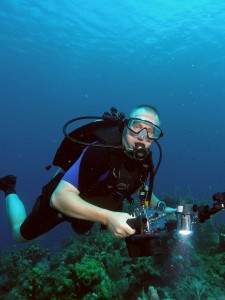
Jeff Bates, a judge on the Missouri Court of Appeals, has been working in law for 30 years — and he’s been scuba diving for 17.
Since the judge started this hobby, he says he has been on “over 800 dives, about three-quarters of which were in the ocean.” To put this into perspective, only 60 dives are needed to receive certification as a Divemaster from PADI (Professional Association of Diving Instructors).
He speaks romantically about diving, which might inspire others to look into diving as well.
Bates sat down with The Scoop to share his experiences pursuing the hobby.

Q: What made you pursue this hobby?
A: My law partner and his son were going to take a trip to the Bahamas to go diving and so they wanted to get certified. They figured out it would be a lot cheaper if they could get five people instead of just the two of them (for the diving certification class) [laughs].
Q: What did the process of pursuing this hobby include?
A: We took a series of classroom lectures and exams that we had to pass. We learned how to do underwater scuba skills in the pool … and did a series of training dives at Table Rock Lake to show proficiency in all the skills we had learned.
Q: When you are on a dive trip, what is the process you go through for preparation through actually going in the water?
A: Many of the trips we picked are off of a dive boat. The first thing you do before you get on the boat is get your gear all packed. Basically what I do is lay out all of my equipment as if I had been a diver that had been run over by a steam roller. … You get all that laid out flat to make sure you haven’t missed anything, and you put all that in your bag then get on the boat. Once you get on the boat the instructor … will do what’s called a dive briefing. They generally draw a picture of sites that you’re going to be diving on a white board. They explain … the profile and plan of the dive….
Q: After all of that, what does it feel like to be in the water?
A: When I’m in the water, I am completely relaxed because it’s extremely quiet. The only sound I hear usually is the sound of my regulator, or I may hear a boat engine a long way off or something, but mostly you’re just floating and moving through the water. It’s very liberating because you literally do float in the water. It’s like you’re flying. … It’s a wonderful experience.
Q: Can you dispel some of the fears that people may associate with diving?
A: One thing that makes you confident as the diver is understanding your environment, how your equipment works, and the things you do to keep yourself safe underwater. So really having a good training base is helpful. The other thing to remember, too, is that diving is so much safer than swimming. Because if you do it right, you have an attached air supply. If you’re underwater you’re just fine because you have a way of breathing and maintaining life support there. … It’s part of your job as a diver to educate yourself about the hazards. … Don’t reach into little, dark holes when you’re diving in a coral reef. You never know what’s in there. … You shouldn’t touch anything, ever.… And not to be unduly afraid of things you shouldn’t be afraid of. We see sharks all the time diving … and they don’t care anything about me, so there’s no reason to be scared about them.
Q: Would you have any advice for people who want to pursue this hobby but don’t really know much about it?
A: I would ask them to go by a scuba shop that does instruction and talk to one of the instructors because many times people find that whatever concerns or fears they have are greatly alleviated when they talk to a real, professional instructor. They can tell more about what the process is like and what the training is like and explain how safe diving really is.
Q: What is your fondest memory you have from diving?
Probably the most interesting thing I ever did was my neighbor and I [and my son], went to Bennett Springs, and we dived to the bottom of the spring hole over there. … It’s like a funnel, wide at the top and narrow at the bottom, and you dive down at the bottom of that big crack in the limestone where all the water gushes out. We’re down there putting our hands in the outflow — it’s like 26 million gallons a day through this little hole that’s about 4 inches wide and about 6 feet high. It’s unbelievable how much water comes out of there. It was beautiful: The water was clear, it was cold, and the funnel was half full of gravel that had been spit out of this little crack over the years, so it was diving down this really clean gravel pitch. When you get in there, the sound of that water coming out is like a freight train. It was like being inside a railroad tunnel with a train going by all the time because the sound is just unbelievable and overwhelming.